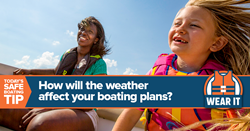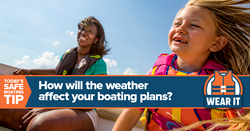
“Many people do not think about or plan for the impact weather conditions can have on their boating safety. It’s critical that they check the weather conditions, including water temperature, before their departure and regularly check for updates.” – Darren Wright, NOAA’s National Weather Service
MANASSAS, Va. (PRWEB)
May 10, 2021
For the annual celebration of National Safe Boating Week, held May 22-28, 2021, the National Safe Boating Council (NSBC) and the National Oceanic and Atmospheric Administration’s (NOAA’s) National Weather Service encourage boaters to follow health and safety guidelines from the Centers for Disease Control (CDC) and local officials while boating responsibly.
The NSBC and NOAA’s National Weather Service have partnered to share safety information for National Safe Boating Week since 2000. Boating safety information can be found at https://www.weather.gov/safety/safeboating-week and https://safeboatingcampaign.com/resources/2021-national-safe-boating-week-toolkit/.
“We are excited to kick off this year’s National Safe Boating Week in partnership with NOAA’s National Weather Service to promote fun and responsible boating,” said Peg Phillips, executive director of the National Safe Boating Council and lead organization for the Safe Boating Campaign. “We believe wearing a life jacket is the simplest way to ensure the safety of you and your loved ones while enjoying a day on the water.”
U.S. Coast Guard statistics show that drowning was the reported cause of death in four out of every five recreational boating fatalities in 2019, and that 86 percent of those who drowned were not wearing life jackets.
In partnership with the U.S. Coast Guard, the NSBC’s Safe Boating Campaign recommends all boaters wear a life jacket. There are innovative options, such as inflatable life jackets, allowing mobility and flexibility for activities like boating, fishing, paddling or hunting, and are much cooler in the warmer weather.
In addition, NOAA urges boaters to think about the impact of the weather on their boating outings.
“Many people do not think about or plan for the impact weather conditions can have on their boating safety,” said Darren Wright, national marine program manager at NOAA’s National Weather Service. “It’s critical that they check the weather conditions, including water temperature, before their departure and regularly check for updates on potentially changing conditions.”
Boaters should have at least two communications devices with them when on the water that work when wet. Satellite phones, emergency position indicating radio beacons (EPIRB), VHF radios and personal locator beacons (PLB) are recommended as cell phones are not reliable in emergency situations. It is also a good idea to bring a NOAA Weather Radio (NWR) receiver to keep track of weather conditions. The NWR network (https://www.weather.gov/nwr/Maps) provides near continuous coverage for most coastal areas served by NWS offices. Typical coverage is up to 25 nautical miles offshore. The U.S. Coast Guard broadcasts coastal forecasts and storm warnings of interest to the mariner on VHF channel 22A following an initial announcement on VHF channel 16.
NSBC and NOAA are collaborating with other boating safety groups and organizations to encourage safe boating on the water throughout the 2021 boating season. The NSBC is proud to be a Weather-Ready Nation Ambassador, as a part of NOAA’s Weather Ready Nation initiative.
About the National Safe Boating Council
The National Safe Boating Council (NSBC) is a national catalyst for recreational boating safety and organizer of the Safe Boating Campaign, with support from boating safety advocates around the world. The Safe Boating Campaign is produced under a grant from the Sports Fish Restoration and Boating Trust Fund, administered by the U.S. Coast Guard. For more information, please visit https://www.safeboatingcouncil.org.
About NOAA
NOAA’s National Weather Service is the official government source for weather forecasts, watches and warnings in the U.S. The National Weather Service’s marine forecasts provide timely weather information relating to U.S. coastal and offshore waters, the Great Lakes, and the open oceans to ensure the safety of life and protection of property, promote international and interstate commerce by improving the efficiency of marine operations, mitigate environmental impacts and enhance the quality of life for the United States. NOAA’s National Ocean Service provides navigation products, such as nautical charts, tides and currents, that protect lives, strengthen the maritime economy, and position America for the future.
NOAA’s mission is to understand and predict changes in the Earth’s environment, from the depths of the ocean to the surface of the sun, and to conserve and manage our coastal and marine resources. For more information, please visit https://www.noaa.gov/ and https://www.weather.gov.
Share article on social media or email:

